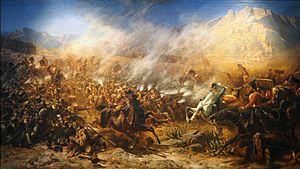Battle of García Hernández facts for kids
Quick facts for kids Battle of García Hernández |
|||||||
|---|---|---|---|---|---|---|---|
| Part of the Peninsular War | |||||||
 Battle of Garcia Hernandez, 23 July 1812, by Adolf Northen |
|||||||
|
|||||||
| Belligerents | |||||||
| Commanders and leaders | |||||||
| Strength | |||||||
| 4,000 | 1,770 | ||||||
| Casualties and losses | |||||||
| 1,600 killed, wounded or captured | 127 killed, wounded or captured | ||||||
The Battle of García Hernández happened on July 23, 1812. It was a small but important fight during the Peninsular War in Spain. In this battle, two groups of British and German cavalry (soldiers on horseback) defeated a much larger French infantry (foot soldiers) force.
The cavalry was led by Major-General Eberhardt Otto George von Bock. The French infantry, about 4,000 strong, was led by Major-General Maximilien Foy. What made this battle special was how the German heavy dragoons (a type of cavalry) managed to break through three French squares. This was very unusual and led to the French army losing many soldiers.
Contents
Why This Battle Happened
The day before this battle, the Allied army, which included British and Portuguese soldiers, won a big victory. This was the Battle of Salamanca, where they defeated a French army. The French army was led by Marshal Auguste Marmont.
Major-General Foy's group was the only French unit that did not fight in the Battle of Salamanca. On July 23, 1812, Foy's soldiers were acting as the "rearguard." This means they were protecting the main French army as it retreated.
The Battle Unfolds
General Bock's heavy cavalry group, called a brigade, led the chase after the French. This group had about 770 soldiers. They were from the 1st and 2nd King's German Legion (KGL) Dragoons.
Another British light cavalry brigade, with 1,000 soldiers, supported Bock. This group was led by George Anson. As the British and German soldiers got closer, the French cavalry, led by Maj-Gen Curto, quickly rode away.
Foy then arranged his eight battalions (groups of infantry) on a hill. They formed a defensive shape called a "square" near Garcihernández in Spain. Each square was made of soldiers standing in a box shape, ready to fire at attacking cavalry. Foy had two battalions from each of these regiments: the 6th Light, 39th, 69th, and 76th Line Infantry.
The First Charge
Bock's dragoons charged towards one of the French squares. This square belonged to a battalion of the 6th Light Infantry. The French soldiers waited too long to fire their guns. When they finally shot, some horsemen were killed.
One horse, carrying a dead dragoon, was badly hurt. It crashed into the square like a battering ram. The horse fell, kicking wildly, and knocked down at least six French soldiers. This created a gap in their defensive square. Captain Gleichen quickly rode his horse into this gap, and his soldiers followed him. The square broke apart, and most of the French soldiers surrendered.
Breaking More Squares
Soon, a second French square, higher up the hillside, was charged. The soldiers in this square were already nervous after seeing what happened to the first one. They hesitated when the dragoons rode towards them.
Because they were shaken, the soldiers in the second square quickly started running away. Only those who surrendered remained. Seeing this, Foy quickly pulled back the rest of his troops. Anson's horsemen then helped to round up the remaining French soldiers on the battlefield.
Battle Results
The French army, led by Foy, suffered heavy losses. They had about 200 soldiers killed or wounded. A large number, 1,400 soldiers, were captured.
General Bock's forces had much fewer losses. They had 54 soldiers killed and 62 wounded. The number of killed soldiers was high compared to the wounded. This was because the fighting was very close, and the musket shots were deadly at such short distances. Another report says 52 German soldiers were killed, 69 wounded, and 6 went missing. The total French losses were around 1,100.
In Books and Stories
This battle is featured in some popular books:
- It is shown in Bernard Cornwell's novel, Sharpe's Sword.
- The battle also appears in Susanna Clarke's book, Jonathan Strange and Mr. Norrell. In the story, Jonathan Strange serves with the Duke of Wellington.
See also
 In Spanish: Batalla de García Hernández para niños
In Spanish: Batalla de García Hernández para niños

